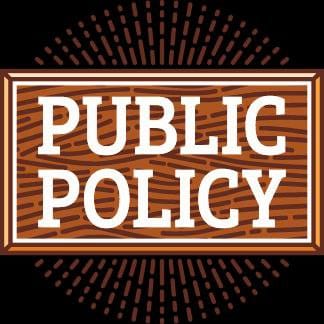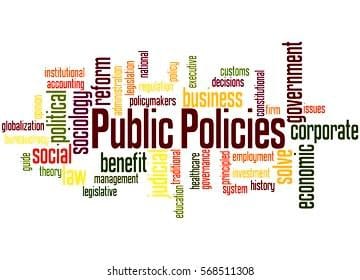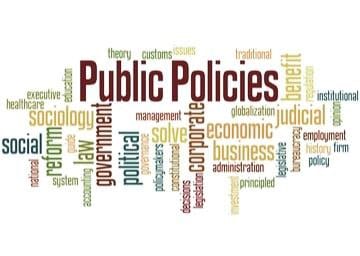Public Policy : Meaning, Features, Type’s, Nature / Characteristics & Significance
Public Policy: Meaning and Features
Meaning of Public Policy
Public policy refers to a set of actions, decisions, and plans formulated by governmental authorities—at the local, national, or international level—to address issues or problems within society. It involves the development and implementation of laws, regulations, courses of action, and funding priorities to achieve specific objectives and guide the behavior of citizens, institutions, and other stakeholders. Public policy encompasses everything from healthcare and education to defense, social welfare, and environmental protection.
Public policy is a deliberate and structured effort by governments to resolve societal issues or enhance the general well-being of citizens.
Features of Public Policy
- Governmental in Nature:
- Public policy is formulated and implemented by the government or public authorities. It is not the product of private individuals or organizations but arises from the political and administrative processes of government institutions.
- Purposeful and Goal-Oriented:
- Public policies are designed to achieve specific objectives. They are intentional actions meant to address societal issues such as unemployment, crime, education, or environmental concerns. Every public policy has a clear set of goals that guide its formulation and implementation.
- Based on Laws and Regulations:
- Public policies often lead to the creation of laws, regulations, rules, and guidelines. These legal instruments provide the framework within which policies are implemented and enforced. For example, education policies may lead to regulations governing school curricula and teacher qualifications.
- Dynamic and Evolving:
- Public policy is not static; it is a dynamic process that evolves in response to changes in the social, economic, and political environment. Governments may update or revise policies to reflect new developments, emerging issues, or shifts in public opinion.
- Involves Multiple Stakeholders:
- Public policy formulation and implementation involve the participation of multiple actors, including elected officials, government agencies, civil society, interest groups, businesses, and the general public. This makes policy-making a collaborative process that takes into account diverse perspectives and interests.
- Problem-Solving Approach:
- Public policy is inherently problem-solving in nature. It is designed to identify and address specific issues or challenges faced by society, such as economic inequality, climate change, public health crises, or national security threats.
- Action-Oriented:
- Public policies are actionable plans that provide a course of action for governments to take. They prescribe specific steps, measures, or interventions to be undertaken to achieve desired outcomes, whether through legislation, administrative procedures, or financial incentives.
- Resource Allocation:
- A critical feature of public policy is that it involves the allocation of resources, including financial, human, and material resources. Policies dictate how government budgets are spent, which sectors receive funding, and what programs or initiatives are prioritized.
- Influenced by Political Ideologies:
- The formulation and implementation of public policies are often influenced by the political ideologies of ruling parties or government leaders. For example, a government with a conservative ideology may prioritize policies that emphasize economic liberalism and deregulation, while a socialist government may focus on social welfare and redistributive policies.
- Public Interest Focused:
- The overarching objective of public policy is to serve the public interest. It aims to promote the well-being and security of citizens, protect rights, and ensure the equitable distribution of resources and opportunities. Public policy is meant to benefit the collective good rather than specific individuals or groups.
- Implementation Mechanism:
- Once formulated, public policy requires a mechanism for implementation. This involves the bureaucracy or administrative agencies responsible for executing the policies. Implementation may involve developing programs, monitoring compliance, and ensuring that policies are effectively put into practice.
- Evaluation and Feedback:
- Public policy often includes provisions for monitoring and evaluation to assess its effectiveness and impact. Feedback mechanisms are essential for understanding whether the policy achieves its intended goals or requires adjustments. This process may involve the collection of data, public consultations, or performance audits.
- Coercive in Nature:
- Public policy is sometimes coercive because it can compel individuals and organizations to act in certain ways through laws and regulations. Governments may enforce compliance through penalties, fines, or other legal consequences to ensure the policy is followed.
- Influence of External Factors:
- Public policies are also shaped by external factors such as international agreements, global events, economic trends, or environmental changes. For example, global economic recessions, climate change, or international conflicts may force governments to revise or create new policies.

Types of Public Policy
- Distributive Policies:
- These policies are focused on the allocation of resources and benefits to specific segments of the population. For instance, agricultural subsidies or infrastructure projects like road construction.
- Regulatory Policies:
- These policies aim to regulate behaviors and activities to ensure compliance with laws or standards. Examples include environmental regulations, food safety laws, and workplace safety standards.
- Redistributive Policies:
- Redistributive policies seek to reallocate resources from one group to another, often with the goal of reducing inequality. Examples include progressive taxation, welfare programs, and social security benefits.
- Constituent Policies:
- Constituent policies establish government structures or processes, such as the creation of new government agencies or reforms to the judicial system.
- Foreign Policy:
- These policies deal with a nation’s external relations and interactions with other countries, including trade agreements, defense strategies, and diplomatic initiatives.
Conclusion
Public policy is a multifaceted and essential component of government functioning, with features that reflect its goal-oriented nature, dynamic process, legal framework, and collaborative involvement of multiple stakeholders. By addressing societal issues and guiding governmental action, public policies play a crucial role in shaping the economic, social, and political fabric of any society.
Public Policy : Nature and Characteristics
Public policy refers to the actions and decisions made by governmental authorities to address societal issues and regulate the behavior of individuals, organizations, and institutions. It is the result of a deliberate process that aims to address specific public needs or problems through laws, regulations, programs, or actions. The nature and characteristics of public policy reflect its complexity and its role in shaping societal governance.
Nature of Public Policy
- Purposeful and Goal-Oriented:
- Public policy is intentionally designed to achieve specific objectives and solve particular societal issues. It is not random or accidental but a deliberate set of actions crafted to meet desired goals, such as economic growth, social justice, public safety, or environmental protection.
- Public Interest Focused:
- Public policy is meant to serve the collective good or the broader public interest. It prioritizes the welfare of society as a whole over the interests of specific individuals or groups. It aims to address public issues that affect a large segment of the population, such as healthcare, education, or national security.
- Dynamic and Adaptive:
- Public policy is dynamic and continuously evolving in response to changes in the social, economic, political, and technological environment. Governments regularly revise or introduce new policies to address emerging challenges, such as shifts in public opinion, new research, or global events like pandemics or economic crises.
- Political in Nature:
- Public policy is inherently political because it involves decision-making by elected officials and policymakers who are influenced by political ideologies, public opinion, and party interests. The formulation and implementation of policies often reflect the values, priorities, and beliefs of those in power.
- Complex and Multifaceted:
- The process of making public policy is complex, involving multiple stakeholders, layers of analysis, negotiation, and compromise. It requires balancing competing interests, resources, and societal goals. Policymakers must consider legal, economic, social, and ethical dimensions when formulating policies.
- Interdisciplinary:
- Public policy draws on a wide range of disciplines, including economics, political science, sociology, law, and public administration. This interdisciplinary nature allows policymakers to develop comprehensive solutions to complex societal problems by integrating knowledge from various fields.
- Action-Oriented:
- Public policy is actionable, meaning it results in concrete actions taken by government institutions. These actions include passing laws, creating programs, allocating funds, and enforcing regulations to implement the policy objectives.

Characteristics of Public Policy
- Formulated by Government:
- Public policy is primarily formulated and enacted by government authorities. While input may come from non-governmental actors, such as interest groups, think tanks, and the public, the responsibility for crafting and implementing public policy lies with governmental institutions.
- Based on Law and Legislation:
- Public policy is often codified in the form of laws, regulations, and executive orders. These legal frameworks provide the necessary authority and mechanisms for implementing policy decisions and ensuring compliance among citizens and organizations.
- Coercive in Nature:
- Public policy has a coercive aspect because it is enforceable by law. Governments have the power to compel individuals, businesses, and institutions to comply with policy measures through regulations, penalties, fines, or other forms of enforcement.
- Aims to Solve Public Problems:
- Public policy is focused on problem-solving. It seeks to address societal challenges such as poverty, inequality, public health crises, crime, environmental degradation, or unemployment. The primary goal is to provide solutions that benefit the public and improve the quality of life.
- Resource Allocation:
- Public policy involves the allocation of resources—both financial and human. Governments allocate budgets and resources to implement policies and programs. For example, healthcare policy requires funding for hospitals, medical staff, equipment, and services.
- Involves Multiple Stakeholders:
- Public policy is shaped by the input and influence of various stakeholders, including government officials, the public, businesses, advocacy groups, non-governmental organizations (NGOs), and international actors. Policymakers must consider these diverse interests and perspectives when formulating and implementing policy.
- Implementation by Bureaucracy:
- Once public policy is formulated, it is typically implemented by the bureaucracy, which consists of administrative agencies and government officials responsible for executing the policies. Effective implementation requires well-defined procedures, coordination, and oversight.
- Subject to Evaluation and Feedback:
- Public policies are often subject to monitoring, evaluation, and revision. After implementation, policies are evaluated to assess their effectiveness, efficiency, and impact on society. Based on feedback and analysis, policies may be revised, improved, or even repealed.
- Influenced by Public Opinion and Interest Groups:
- Public policy is often shaped by public opinion and the influence of interest groups. Public sentiment can drive policy changes or modifications, especially in democratic systems where elected officials respond to their constituents’ demands. Interest groups and lobbyists also play a role in advocating for specific policies.
- Responsive to Global Factors:
- Public policy is not created in isolation. It is often influenced by international developments such as global trade agreements, climate change accords, economic trends, and international conflicts. Policies may be adapted to align with international standards or respond to global challenges.
Conclusion
The nature of public policy is characterized by its goal-oriented, dynamic, and interdisciplinary approach, while its characteristics highlight the role of government, resource allocation, and the involvement of various stakeholders. Public policy is essential for addressing societal issues and ensuring that governments can effectively manage and improve the welfare of their citizens. Its formulation and implementation are complex processes that balance political, legal, and social considerations to achieve collective objectives.

Significance of Public Policy
Public policy plays a crucial role in shaping societies by addressing collective issues and guiding the actions of government and citizens. Its importance is multifaceted, as it impacts the economy, social justice, governance, and overall well-being. Below are the key reasons why public policy is significant:
1. Solves Societal Problems
- Public policy is designed to address and solve societal challenges such as poverty, healthcare access, unemployment, environmental degradation, education gaps, and more. By creating targeted policies, governments can develop sustainable solutions to complex problems that affect the well-being of society.
2. Guides Government Action
- Public policy serves as a blueprint for government action, providing direction for lawmakers, administrators, and public servants. It outlines the objectives, principles, and strategies that government agencies must follow, ensuring that government activities are consistent, effective, and aligned with national goals.
3. Promotes Social Justice
- Public policies are critical in promoting social justice and equity by ensuring fair distribution of resources and opportunities. Policies related to welfare, healthcare, education, and housing aim to reduce inequalities and ensure that vulnerable populations have access to essential services.
4. Protects the Public Interest
- Public policy protects the collective interests of society by regulating behaviors and activities that could harm the public. Policies related to public health, safety, environmental protection, and consumer rights safeguard the public from risks, ensuring a safer and healthier society.
5. Stimulates Economic Growth
- Economic policies are a core component of public policy. By managing taxation, trade, infrastructure, and investment, public policy can promote economic growth, stability, and development. Policies that support innovation, entrepreneurship, and job creation can help boost a nation’s economy.
6. Provides a Legal Framework
- Public policy often results in the creation of laws and regulations that provide a structured legal framework within which society operates. These laws help define acceptable behavior, resolve disputes, and create standards for businesses, organizations, and individuals.
7. Ensures National Security
- Public policy is crucial for national defense and security. It provides the framework for maintaining law and order, protecting borders, managing foreign relations, and responding to threats such as terrorism or cyberattacks.
8. Encourages Innovation and Development
- Through policies related to science, technology, and education, public policy can foster innovation and development. Governments can incentivize research and development, support new technologies, and encourage industries that contribute to national progress.
9. Enhances Democratic Governance
- Public policy plays a fundamental role in enhancing democratic governance. It provides mechanisms for citizen participation, transparency, and accountability in government actions. Policies that promote democratic principles, human rights, and civic engagement ensure a robust and participatory democracy.
10. Regulates Markets and Ensures Fair Competition
- Public policy helps in regulating markets to prevent monopolies, unfair trade practices, and exploitation. Through competition policies, antitrust laws, and trade regulations, governments can ensure that markets remain competitive and consumers are protected.
11. Adapts to Global Challenges
- In an increasingly interconnected world, public policy is essential for addressing global challenges such as climate change, migration, pandemics, and international trade. Policies that promote sustainability, environmental protection, and global cooperation help nations deal with issues that transcend borders.
12. Promotes Environmental Sustainability
- Environmental policies focus on ensuring the sustainable use of natural resources, protecting ecosystems, and combating climate change. By implementing regulations on emissions, waste management, and conservation efforts, public policy plays a key role in preserving the environment for future generations.
13. Improves Public Services
- Public policy helps improve the quality and accessibility of public services such as healthcare, education, transportation, and housing. Effective policies ensure that these services are affordable, efficient, and meet the needs of the population, contributing to overall social development.
14. Increases Accountability and Transparency
- Public policy promotes accountability and transparency in government activities by setting guidelines for how decisions are made and how resources are allocated. Policies related to governance, anti-corruption, and public finance management help to prevent misuse of power and resources.
Conclusion
Public policy is essential for the smooth functioning of societies, as it addresses key social, economic, and political issues while ensuring governance and regulation. It shapes the way governments operate, enhances the quality of life for citizens, promotes social justice, protects the environment, and ensures sustainable development. Public policy plays a vital role in maintaining order, fostering progress, and achieving collective national and global objectives.
Share this content:
Leave a Reply